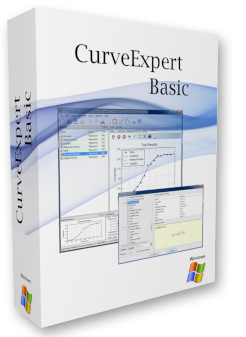CurveExpert Basic
OS Requirements: Windows XP or later.
Overview
CurveExpert Basic was designed to be easy-to-use but powerful, so that all users can obtain a model for their data quickly and easily. XY data can be modeled using a toolbox of linear regression models or nonlinear regression models.
Over 60 models are built-in, but custom regression models may also be defined by the user. Full-featured graphing capability allows thorough examination of the curve fit. The process of finding the best fit can be automated by letting CurveExpert Basic compare your data to each model to choose the best curve.
Capabilities
CurveExpert Basic is a subset of the functionality contained in CurveExpert Professional and is intended for more casual/infrequent users. The major features of the software are enumerated below:
- Easy-to-use User Interface: most mathematically-intensive applications are very difficult to use. CurveExpert Basic has a very intuitive interface, which allows you to import your data, generate results, and create publication-quality plots with very minimal effort. In fact, to import a file takes only four clicks, and generating a battery of results with associated graphs takes two more.
- Robust file import: data files come in many shapes and sizes, and CurveExpert Basic makes importing your data files very easy. The smart file reader avoids non-data areas of your file dynamically, and attempts to find labels for each column of data in your file.
- Publication quality graphs: The rendering of the plots is of publication quality, with full antialiasing support and the ability to customize each graph. Graphs can be saved to a variety of graphics file formats, and they may be directly copied and pasted into another application. Graphs are interactive, with zooming, panning, and autoscaling.
- Built-in models: over 60 built-in nonlinear models, with high-quality automatic initial guesses, are available for use. The provided models cover all of the major families.
- Custom models: you can also define models yourself, using a very large library of built-in mathematical functions, and parameters in your models can take any name that you like.
- Ranking of results: results are automatically ranked by your choice of score, correlation coefficient, standard error, or coefficient of determination.
- Validated: validated against the Statistical Reference Datasets Project of the National Institute of Standards and Technology. These datasets can be downloaded directly at http://www.itl.nist.gov/div898/strd/general/dataarchive.html, but are also included verbatim in the CurveExpert Basic distribution for you to use yourself.
- Quality spreadsheet: the built-in spreadsheet allows you to manually enter data and/or modify it with a suite of data transformation tools. Data entry and cutting and pasting capabilities are as easy as Excel.
- Localization: Importing data or interoperating in European-style environments (which use a comma as a decimal) is extremely easy; regional settings are automatically obeyed, or can be selectively enabled in order to match your particular workflow.
- Logging: a log of actions is kept across sessions of the software, in case you need to recreate a particular result. A messages pane keeps you informed of the status of every computed result.
- Documentation: Extensive documentation in HTML and PDF format, available both directly from the software and online at http://docs.curveexpert.net/curveexpert/basic.
Gallery
Differences with Pro
CurveExpert Basic is a subset of the functionality contained in CurveExpert Professional and is intended for more casual/infrequent users. The list below is a specific list of differences between the two; the items are listed as features that CurveExpert Pro supports, but CurveExpert Basic does not.
- Advanced models
- Functions and custom functions
- Weighting for regressions
- Linear and polynomial splines
- Polynomial regressions only supported up to 4th degree in CurveExpert Basic.
- Built-in digitizer that can be used to generate datasets from images.
- datasets with multiple independent variables are not supported in CurveExpert Basic.
- Three types of smoothers (Moving Average, Lowess, and Savitzky-Golay) that CurveExpert Basic does not include.
- Extended result detail, residuals, convergence curves, and parameter histories shown in CurveExpert Pro.
- Ability to evaluate points on the resulting curve fit, differentiate, integrate, and compute arclength is included in CurveExpert Pro.
- In CurveExpert Pro, new plots can be created and customized with any results placed upon them; in CurveExpert basic, there is one plot per result.
- Comparing two regressions is not supported in Basic
- Multiple cores when computing large sets of results; CurveExpert Basic does not.
- User customizable plug-ins
- User customizable graph themes
- 3D visualization
- graphing: annotations and addition of shapes and images not supported in CurveExpert Basic.
- Hot linking (tracking of data file updates) not supported in CurveExpert Basic.

